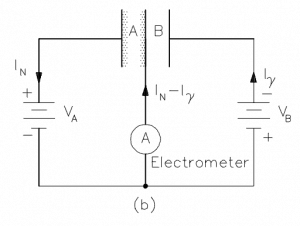
The ionization chamber, also known as the ion chamber, is an electrical device that detects various types of ionizing radiation. The voltage of the detector is adjusted so that the conditions correspond to the ionization region, and the voltage is insufficient to produce gas amplification (secondary ionization). Ionization chambers are preferred for high radiation dose rates because they have no “dead time,” a phenomenon that affects the accuracy of the Geiger-Mueller tube at high dose rates.
The compensated ion chamber is utilized in the intermediate range because the current output is proportional to the relatively stable neutron flux, compensating for gamma flux signals. The compensated ion chamber consists of two detectors in one case. The outer chamber is coated inside with boron-10, while the inner chamber is uncoated. The coated chamber is sensitive to gamma rays and neutrons, while the uncoated chamber is sensitive only to gamma rays. By properly connecting the two chambers, the net electrical output from the detector will be the current due to neutrons only.
The voltages between these two sets of electrodes must be balanced to achieve the proper amount of gamma compensation. The consequences of operating with an overcompensated or under compensated chamber are important. If the voltage in the compensation chamber is too high, the detector is overcompensated, and some neutron current, as well as all of the gamma current, is blocked. Indicated power is lower than actual core power. If the compensating voltage is too low, under-compensation will occur. At high power, gamma flux is relatively small compared to neutron flux, and the effects of improper compensation may not be noticed. It is extremely important, however, that the chamber be properly compensated during reactor startup and shutdown.
See also: U.S. Department of Energy, Instrumentation, and Control. DOE Fundamentals Handbook, Volume 2 of 2. June 1992.
